Larval fish sensitivity to a simulated cold-water pulse varies between species and age

Accepted: 27 June 2022
Supplementary: 167
HTML: 135
All claims expressed in this article are solely those of the authors and do not necessarily represent those of their affiliated organizations, or those of the publisher, the editors and the reviewers. Any product that may be evaluated in this article or claim that may be made by its manufacturer is not guaranteed or endorsed by the publisher.
Authors
The release of cold-water from hypolimnetic zones of impoundments sharply reduces downstream riverine water temperature. This cold-water pollution (CWP) can extend for hundreds of kilometres, severely challenging the physiological ability of aquatic fauna, particularly ectotherms such as fish, to maintain essential processes such as metabolism, development and growth and survival. The impact of CWP on native fish, especially early life stages, is poorly known. We investigated the effect of a 24-hour exposure to a range of environmentally-related water temperatures (8, 10, 12, 14, 16, 18 and 20°C) on three age-classes (<24-hour-old, 7-day and 14-day-old larvae) of two Australian native fish species: Murray cod (Maccullochella peelii) and Macquarie perch (Macquaria australasica). Overall, larvae of M. peelii were more sensitive to lower water temperatures and hence CWP than M. australasica, indicated by higher rates of equilibrium loss. Larvae of M. peelii were most sensitive to exposure at seven days old whereas M. australasica larvae were most sensitive at <24-h-old. Using our results, we modelled pre- and post-impoundment temperature scenarios and estimated the downstream CWP footprint for both species in an Australian river reach. Larvae of M. peelii were predicted to be absent from the first 26 km of river downstream of the impoundment compared with no impact on the distribution of M. australasica. Managing riverine water temperature below impoundments is fundamental to promoting positive outcomes for endemic fish on not only a local, but global basis. This study emphasises the differential impact of CWP among the critical early life stages and fish species and highlights the urgent need to better manage hypolimnetic water releases to improve downstream river ecosystems.
Edited by
Pietro Volta, CNR-IRSA Verbania, ItalyHow to Cite

This work is licensed under a Creative Commons Attribution-NonCommercial 4.0 International License.
Similar Articles
- Christine M. Greenaway, Andrew M. Paterson, Wendel (Bill) Keller, John P. Smol, Scaled-chrysophyte assemblage changes in the sediment records of lakes recovering from marked acidification and metal contamination near Wawa, Ontario, Canada , Journal of Limnology: Vol. 71 No. 2 (2012)
- Sonia Endrizzi, Maria Cristina Bruno, Bruno Maiolini, Distribution and biometry of native and alien crayfish in Trentino (Italian Alps) , Journal of Limnology: Vol. 72 No. 2 (2013)
- Kapillesh Balasubramaniam, Kathleen M. Rühland, Andrew M. Paterson, John P. Smol, Revisiting lakes within the Rideau Canal system (Ontario, Canada) to assess the impacts of multiple environmental stressors over the past ~25 years using diatom-based paleolimnology , Journal of Limnology: Vol. 84 (2025)
- Adam H. Quade, Allyse Ferrara, Quenton Fontenot, Raynie Harland, Kelly S. Boyle, Guillaume Rieucau, Mississippi River-floodplain connectivity level mediates fish assemblage dynamics , Journal of Limnology: Vol. 84 (2025)
- Maximiliano D. Garcia, Nicolás Bonel, Environmental modulation of the plankton community composition and size-structure along the eutrophic intertidal coast of the Río de la Plata estuary, Argentina , Journal of Limnology: Vol. 73 No. 3 (2014)
- Roberta Piscia, Norman D. Yan, Marina M. Manca, Mechanisms underlying recovery of zooplankton in Lake Orta after liming , Journal of Limnology: Vol. 75 No. s2 (2016): Lake Orta: a new lease on life
- Lisa Elzi, Edoardo Villa, Nicola Patocchi, Correlation between Phragmites australis growth and seasonal lake level variations in Lake Maggiore (Italy/Switzerland): common reed management guidelines , Journal of Limnology: Vol. 81 No. s2 (2022): Effects of water level management on lake littorals and downstream river areas
- Germán Pérez, Laura Farías, Camila Fernandez, Daniel Conde, Claudia Piccini, Incidence of phytoplankton and environmental conditions on the bacterial ammonium uptake in a subtropical coastal lagoon , Journal of Limnology: Vol. 73 No. 1 (2014)
- Hongliang Zhang, Jinglu Wu, Long Ma, Shuie Zhan, Miao Jin, Zhangdong Jin , Sediment biomarkers record hydrological and anthropogenic-driven environmental changes since 1800 AD in the Ili-Balkhash Basin, arid Central Asia , Journal of Limnology: Vol. 83 (2024)
- Sean Murray Marr, Anthony Michael Swemmer, Hydrological characteristics of extreme floods in the Klaserie River, a headwater stream in southern Africa , Journal of Limnology: Vol. 82 (2023)
<< < 18 19 20 21 22 23 24 25 26 27 > >>
You may also start an advanced similarity search for this article.
-
John D. Koehn, Charles R. Todd, Henry Wootton, Michael JoyMarine and Freshwater Research : 2023

 https://doi.org/10.4081/jlimnol.2022.2056
https://doi.org/10.4081/jlimnol.2022.2056





